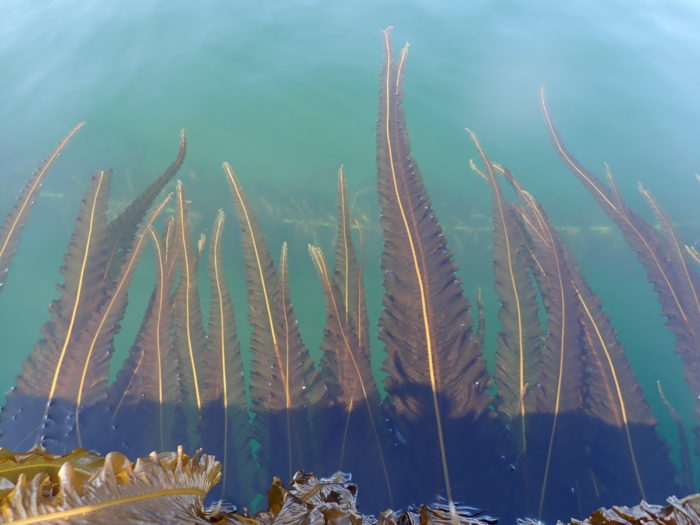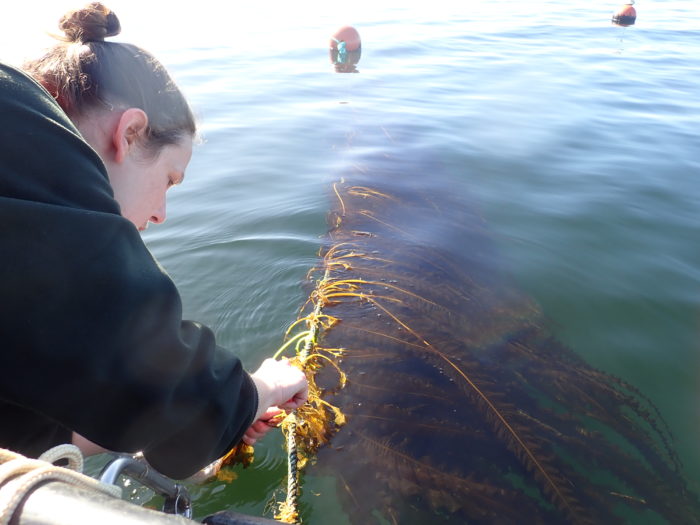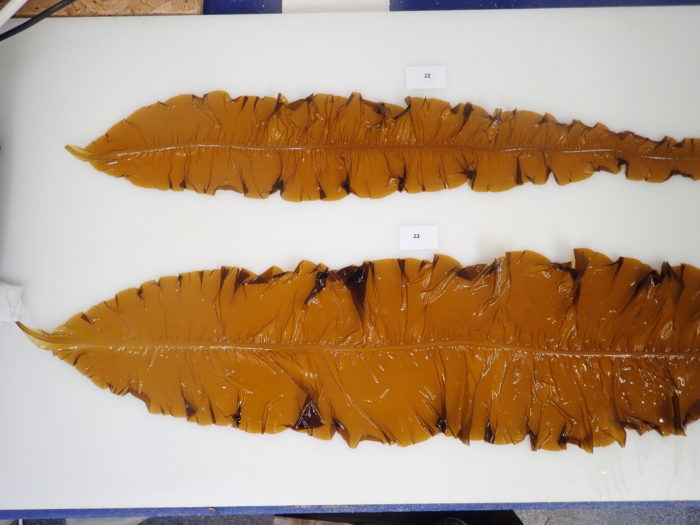Key points about this IMTA site in Ireland
- Name of the site: Port-a-Bhuiltin
- Location: West Coast of Scotland, United Kingdom
- Type of aquaculture production: Coastal
- Provided by: SAMS (The Scottish Association for Marine Science)
Take a look at the site!
Interview:
- Interviewee: Dr Kati Michalek, Postdoctoral researcher in seaweed cultivation at SAMS
- About the coastal aquaculture production site located in Port-a-Bulin Bhuiltin in Scotland, could you tell us a bit about this pilot in terms of size, scale and production?
- KM: The Scottish Association for Marine Science (SAMS) in Oban operates two experimental seaweed farms on the Scottish west coast. Port-a-Bhuiltin is our main site with a lease area of 30 hectares. Here we currently have one grid system for seaweed production in place being 100m x 100m in size thus providing a production area of one hectare. We can deploy up to 24 100-meter-long growing lines, seeded with different kelp species such as Saccharina latissima, Alaria esculenta and Laminaria digitata. SAMS also operates its very own seaweed hatchery where we rear different species depending on our research interests and/or external demands. Our seaweed cultures are seeded onto the growing lines, using both direct and indirect seeding methods, which are then deployed at our site in October and left to grow until harvest in May/June the following year.With a fully deployed site we can produce up to 20 tonnes of seaweed per production cycle i.e. year which is utilised by the various ongoing research projects as well as provided to other interested parties. The overall focus of our operation, however, is not so much tonnage but remains supporting the sector through research and knowledge transfer activities to develop the necessary methods for seaweed cultivation.
Port-a-Bhuiltin is our main site with a lease area of 30 hectares. Here we currently have one grid system for seaweed production in place being 100m x 100m in size thus providing a production area of one hectare. With a fully deployed site we can produce up to 20 tonnes of seaweed per production cycle.

- Why was this site chosen to be a pilot for the IMPAQT project?
- KM: Both seaweed farms operated by SAMS are the only experimental research sites for seaweed production in Scotland. Since the start in 2014, our farms have served as pilot sites for various projects, from small proof-of-concept studies to large multi-partner national and international projects. At SAMS we can draw from many consecutive years of seaweed research to be applied to and further developed under IMPAQT.In fact, the west coast of Scotland has a rich history in the development of aquaculture and the use of seaweed, and our complex and productive coastline makes it an ideal environment for IMTA developments. Considering the existing scale of the salmon industry and its importance to rural communities, methods must be found to support the sustainability of the Scottish aquaculture sector at large. As such, it seems all to natural to trial an IMTA site next to one of the UK’s oldest marine research stations and build-up on the knowledge gained in other IMTA related projects partnered by SAMS [IDREEM, INTEGRATE].
Both seaweed farms operated by SAMS are the only experimental research sites for seaweed production in Scotland. The west coast of Scotland has a rich history in the development of aquaculture and the use of seaweed.
3. What are the current practices that relate to Integrated Multi-Trophic Aquaculture? Could you describe for us the ecosystem living in this site?
KM: Our pilot site is located close to the shore and regularly visited by otters and sea birds. The seaweed itself further provides the perfect nursing ground for fish such as lumpsucker and a plethora of invertebrate species including mussels, starfish, sea snails and amphipods, to name only a few.
Being situated in the same water body as several salmon farms, our site focusses on extractive species to maximise the benefits of a system that supports the growth of multiple species and industries that typically exploit similar methods and supply chains. IMPAQT allows us to trial the concept of co-cultivation of seaweeds and shellfish by growing oysters in cages floating on the water surface with seaweed growing lines deployed underneath. Besides this, SAMS has been carrying out work within IMPAQT and other projects to better understand the habitat created by the cultivated stock and supporting structures, quantify the positive and negative ecosystem changes, and identify mitigation options for an expansion of the IMTA approach.

- What are the expected benefits from IMPAQT for this site? Since the beginning of the project in May 2018, have you already identified some benefits?
- KM: Research projects such as IMPAQT enable us to further develop our aquaculture work and SAMS to continue its engagement with several cultivation companies so that lessons learnt can be adopted by the wider industry. For example, the close collaboration with our neighbouring oyster grower allows us to compare the performance of oysters in monoculture with the oyster-seaweed system trialled at our site. This is not only to show that the concept of co-cultivation may not only provide performance and production benefits for either species but also to use available growing space more efficiently while providing additional income revenues for small-scale producers. Defining producer- and site-specific requirements – e.g. when is the best time to deploy and harvest the crop? – in combination with close monitoring, is particularly important for a sustainable and effective management of aquaculture sites. We at SAMS are proud to play a part in this development and are excited for the future of Scottish and European aquaculture.
Research projects such as IMPAQT enable us to further develop our aquaculture work and SAMS to continue its engagement with several cultivation companies so that lessons learnt can be adopted by the wider industry.
- What are the required parameters to be monitored in site/tests to be held for IMPAQT?
- KM: Our research is mainly focussed on optimising seaweed production and productivity. As such we want to better understand the growth performance of different species and how this is affected by prevailing environmental conditions. Key natural cues for seaweed are water temperature, sunlight, nutrients and the current and wave patterns at the site. Within IMPAQT we will monitor these and other parameters very closely and at different depths of cultivation. At the same time, we will follow the development in seaweed growth, morphology and composition over time and in relation to the environmental conditions recorded.







